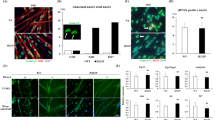Summary
The trigger calcium hypothesis of signal transmission between T-tubules and terminal cisternae (TC) of the sarcoplasmic reticulum (SR) in twitch muscle fibres implies the presence of calcium along T-tubule membranes at rest and its release upon excitation. To test this hypothesis, calcium was immobilised using a fixing and precipitating solution of glutaraldehyde in phosphate buffer at pH 8.0 and the calcium was substituted for by lead. Simultancous tension recordings revealed the occurence of contra tions or a burst of twitches upon perfusion with the tixative. Procaine or tetrodotoxin (TTX) was used to inhibit this activity. In fibres without fixative-induced activity, precipitates were observed along T-tubules and in adjoining parts of TC. In activated fibres, tubular and TC precipitates were absent. These results are consistent with the trigger calcium hypothesis. In fibres activated by depolarisation, calcium returned to TC after passing successively through different parts of the SR.
Similar content being viewed by others
References
Adrian RH, Chandler WK, Hodgkin AL (1970) Voltage clamp experiments in striated muscle fibres. J. Physiol (London) 208:607–644
Betz W, Sakmann B (1973) Effects of proteolytic enzymes on function and structure of frog neuromuscular junctions. J Physiol (London) 230:673–688
Birks RI (1965) The sarcoplasmic reticulum of twitch fibers in the frog sartorius muscle. In: Paul WM, Daniel EE, Kay CM, Monckton G (eds) Muscle. Pergamon Press, Oxford, pp 199–216
Bianchi CP (1968) Pharmacological actions on excitation-contraction coupling in striated muscle. Fed Proc 27:126–131
Borgers M, Thone P, Verheyen A, Ter Keurs HEDJ (1984) Localization of calcium in skeletal and cardiac muscle. Histochem J 16:295–309
Boskey AL, Pozner AS (1982) Optimal conditions for Ca-acidic phospholipid-PO4 formation. Calcif Tissue Int 34:S1-S7
Carasso N, Favard P (1966) Mise en evidence du calcium dans les myonèmes pédiculaires de ciliés péritriches. J Microsc (Paris) 5:759–770
Caswell AH, Lau YH, Brunschwig J-P (1976) Ouabain-binding vesicles from skeletal muscle. Arch Biochem Biophys 176:417–430
Close RI, Lännergren JI (1984) Arsenazo III calcium transients and latency relaxation in frog skeletal muscle fibres at different sarcomere lengths. J Physiol (London) 355:323–344
Elder HY, Gray CC, Jardine AG, Chapman JN, Biddlecombe WH (1982) Optimum conditions for cryoquenching of small tissue blocks in liquid coolants. J Microsc (Oxford) 126:45–61
Frank GB (1978) Antagonism by phosphate buffer of the twitch loss in isolated muscle fibers produced by calcium-free solutions. Can J Physiol Pharmacol 56:523–526
Frank GB (1980) The current view of the source of trigger calcium in excitation-contraction coupling in vertebrate skeletal muscle. Biochem Pharmacol 29:2399–2406
Franzini-Armstrong C (1971) Studies of the triad. II. Penetration of tracers into the junctional gap. J Cell Biol 49:196–203
Mathias RT, Levis RA, Eisenberg RS (1980) Electrical models of excitation-contraction coupling and charge movement in skeletal muscle. J Gen Physiol 76:1–31
Narahashi T, Deguchi T, Urakawa N, Ohkubo Y (1960) Stabilization and rectification of muscle fiber membrane by tetrodotoxin. Am J Physiol 198:934–938
Northover AM (1985) The release of membrane-associated calcium from rabbit neutrophils by fixatives. Implications for the use of antimonate staining to localize calcium. Histochem J 17:443–452
Ornberg RL, Reese TS (1980) A freeze-substitution method for localizing divalent cations: examples from secretory systems. Fed Proc 39:2802–2808
Politoff AL, Rose S, Pappas GD (1974) The calcium binding sites of synaptic vesicles of the frog sartorius neuromuscular junction. J Cell Biol 61:818–823
Reynolds ES (1963) The use of lead citrate at high pH as an electron-opaque stain in electron microscopy. J Cell Biol 17:208–212
Sakai T (1965) The effects of temperature and caffeine on activation of the contractile mechanism in the striated muscle fibres. Jikeikai Med J 12:88–102
Schneider MF, Chandler WK (1973) Voltage dependent charge movement in skeletal muscle: a possible step in excitation-contraction coupling. Nature 242:244–246
Schwarz W, Palade PT, Hille B (1977) Local anesthetics. Effect of pH on use-dependent block of sodium channels in frog muscle. Biophys J 20:343–368
Shanes AM, Freygang WH, Grundfest H, Amatniek E (1959) Anesthetic and calcium action in the voltage clamped squid giant axon. J Gen Physiol 42:793–802
Somlyo AV, Gonzales-Serratos H, Shuman H, McClellan G, Somlyo AP (1981) Calcium release and ionic changes in the sarcoplasmic reticulum of tetanized muscle: An electron-probe study. J Cell Biol 90:577–594
Sorenson MM, Reuben JP, Eastwood AB, Orentlicher M, Katz GM (1980) Functional heterogeneity of the sarcoplasmic reticulum within sarcomeres of skinned muscle fibers. J Membr Biol 53:1–17
Stern MD, Kort AA, Bhatnagar GM, Lakatta EG (1983) Scattered-light intensity fluctuations in diastolic rat cardiac muscle caused by spontancous Ca++-dependent cellular mechanical oscillations. J Gen Physiol 82:119–153
Sugi H, Daimon T (1977) Translocation of intracellularly stored calcium during the contraction-relaxation cycle in guinea pig taenia coli. Nature 269:436–438
Uhrik B, Zacharová D (1979) Three-dimensional arrangement of sarcoplasmic reticulum in crayfish as seen by high voltage electron microscope. Cell Tissue Res 202:343–346
Uhrik B, Zacharová D (1982) Les differentes localisations du calcium dans les fibres musculaires de la Grenouille et de l'Ecrevisse au cours de l'activation de la contraction (vue avec une technique histochimique). J Physiol (Paris) 78:50A
Uhrík B, Zacharová D (1986) Histochemical demonstration of changes in calcium content along T-tubule membranes in frog twitch muscle fibres. J Muscle Res Cell Motil 7:92
Winegrad S (1968) Intracellular calcium movements of frog skeletal muscle during recovery from tetanus. J Gen Physiol 51:65–83
Wussling M, Schenk W (1986) Investigation of laser diffraction and speckle patterns from skeletal and heart muscle preparations. Physiol Bohemoslov 35:376–377
Zachar J, Zacharová D, Henček M (1964) Membrane potential of the isolated muscle fibre of the crayfish (Astacus fluviatilis). Physiol Bohemoslov 13:117–128
Author information
Authors and Affiliations
Rights and permissions
About this article
Cite this article
Uhrik, B., Zacharová, D. Histochemical study of calcium on T-tubule membranes and in the sarcoplasmic reticulum, in frog twitch muscle fibres at rest and during activity. Histochemistry 86, 305–310 (1987). https://doi.org/10.1007/BF00490263
Received:
Accepted:
Issue Date:
DOI: https://doi.org/10.1007/BF00490263




